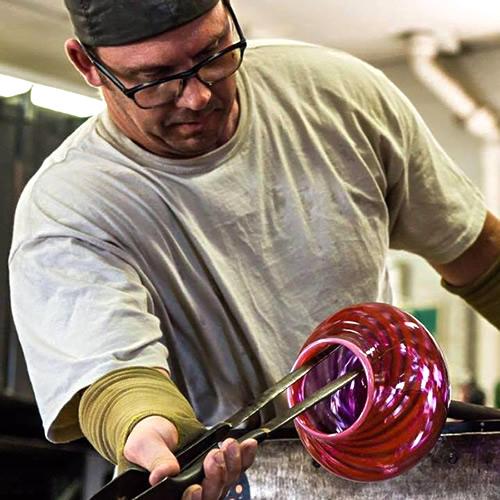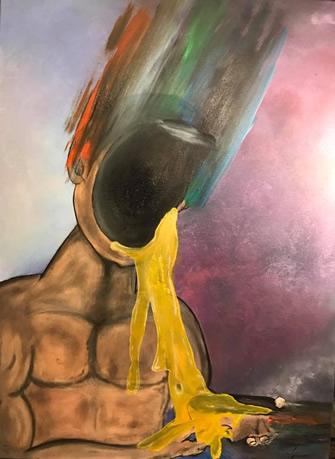Veterans' Voices: Christopher Stowe
Christopher Stowe is a retired Marine master gunnery sergeant who is currently working with several glassblowing studios in Florida to create military and veterans’ programs designed to help them learn the art of glassblowing as a means of therapeutic art.
Artistic expression and military members do not typically go hand in hand. Imagine asking a prototypical special operations member to express themselves in an artistic manner, and you can imagine the myriad responses one might get in return. The mask-making exercise can cause several positive critical assessments if approached honestly. The theme of self-awareness enmeshed with family, military community, and society stirs very deep and personal feelings within the service member, and I feel that this exercise allows them to nonverbally “tell their story.” Service members (depending on level of injury) can and do have real problems communicating their problems; mask making allows the self-assessment to literally speak for itself. One only has to look at the examples of the masks at NICoE to see there is no ambiguity in how a particular service member was feeling or what they were trying to convey when they were making their mask. I can attest to the mixed emotions that can be felt during a mask-making exercise: guilt, fear, and self-loathing/self-doubt at first, then, while moving through the making of the mask, feelings of exhilaration, freedom, resolution, and accomplishment can start to emerge.

The themes of sense of self, family, military community, and society are vital to work through in order to start and/or continue the healing process. The masks give a member a starting point to move out from in order to begin to heal. This exercise is typically done as one of the first exercises in the art therapy program at NICoE, and I feel that helps to crystallize the way ahead for any given member. I know that it helped show the way for me as it pertained to how I personally viewed myself. (“Normal” on the outside, demon and broken on the inside.) I also feel that this nonverbal tool allows the member to expose themselves in a controlled setting with an art therapist, without having to belabor long talk therapy sessions in order draw out the key pieces that a member needs help dealing with, while creating a very visceral trust exercise with the art therapist and the member in a non-judgmental way. The mask making and the themes addressed in this exercise open the doorway to healing in a very authentic and accelerated way that other forms of therapy cannot address in the same fashion.
Art therapies and community arts engagement programs have completely changed how I view therapeutic modalities. Art therapies help to move towards a more “whole of person” approach to therapy. No single form of therapy in my opinion is the be-all and end-all. One individual may or may not respond well to traditional forms of therapy but will accelerate greatly in their healing when art therapy modalities are applied in concert with more traditional methods. Creative self-expression has long been a form of healing throughout cultures around the world, but it really is only in recent times that art as therapy has been medically recognized, much to my (and many others) benefit. The readily apparent benefits of increased confidence, mental acuity, physical dexterity, improved self-worth, and decrease in depression have all been wonderfully positive aspects to me that were and are derived from art therapy. However, the unintended positive consequences of art therapy as well as engaging with traditional nonmilitary communities (local art communities) have been equally beneficial to me. Some of these unintended positive consequences for me have been:
- increased interaction with other people,
- a much greater appreciation of people that have never served and what their lives and opinions look like,
- a much healthier overall appreciation for human life and perspectives, as well as
- a deepened and renewed commitment to help my fellow service members through the advocacy of art therapy.
I can state unequivocally that art therapy has helped me to be a better human, husband, father, and friend. I can also state unequivocally that art therapy has helped save my life.
One of the more pressing needs to improve reintegration efforts for military and veteran populations back into their respective communities is addressing the very real divide between those that have served and those that have not served from BOTH perspectives. If military members and veterans are honest with themselves, they would acknowledge that we [military and veterans] at times can set up just as many barriers against the civilian population to try and “know” us as civilians can at times set up in order to avoid understanding service men and women. Both sides I think generally feel that one side cannot possibly understand the other. In some instances, that may ring true. I feel that in order to bridge this divide, both sides have to engage in critical and substantive dialogue on the things that matter to both communities. This dialogue can and will be difficult, contentious at times, and passionate, but necessary to heal this divide and the communities they reside in to the benefit of all in the long run. Trauma is processed the same way in the brain and body regardless of how it was introduced, (military combat, child abuse, sexual trauma, alcoholism, etc.) and neither the military and veteran population nor the civilian sector has the patent on trauma. Moving forward together can help find the common thread that bonds and heals us all.
There can be no greater or organic path to this conversation than through the arts, art therapy, and community art programs. From working with organizations or artisans (regardless of whether military or civilian) in local communities to help generate military and veteran art opportunities, the one thing I have noticed is when you put civilian artists and military and veteran artists together in a program, you end up with a program full of just artists on the other side. And one of the amazing things you see also is wonderfully expressive and dynamic art that is deeply collaborative and meaningful to both sides. Real conversation happens between these groups at the easel, the pottery wheel, the glassblowing studio, open mic night, the theater troupe, and at all the other amazing mediums that are enjoyed within the arts. Art itself is meant to stimulate conversation and take on difficult social topics and I can think of no nobler mission for art than that of healing.


